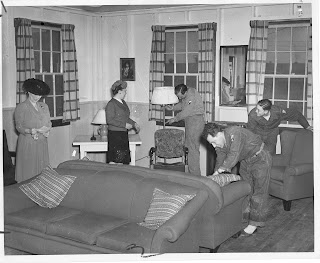One portion of the Benton County history exhibition in the historical society's Corvallis Museum is devoted to artifacts related to Camp Adair. Today, most people in the county have no memory of the base and its impact on the county. The photographs, documents, and artifacts in the Benton County Historical Society's collection can combine to provide a picture of this part of our history.
In February, 1941, the United States War Department decided that there was a need to build three new Army basic training camps on the West Coast. By July, 1941, the army had chosen a site of 56,800 acres in a rectangle 6 miles wide by 10 miles long, located 8 miles north of Corvallis, 8 miles south of Monmouth and six miles west of Albany. Highway 99W ran through the site. In addition to its access to transportation, the site was valued for the similarity of terrain to what recruits would find in Europe.
Within six months, the camp's 1700 buildings had been constructed at a cost of $32 million. That such a large project could be completed that quickly is truly amazing.
The buildings included waste water and fresh water treatment plants, a heating plant, 500 barracks, 11 chapels, 5 movie theaters, 13 post exchanges, 2 service clubs, a hospital, a field house with 3 basketball courts, a bakery, 2 guest houses, a bank, a post office, phone exchange, warehouses, headquarters offices, firing ranges, an electrical substation, an airfield, rail yards, and a mock German village.
To equip the 96 dayrooms, the army asked local communities for second hand furniture and recreational equipment, which many contributed.
The soldiers who were to train the new recruits arrived in the summer of 1942 and the recruits in the fall. Four divisions were stationed there, as noted on this sign. They included 40,000 people, making Camp Adair the second-largest city in the state at the time.
What the soldiers in these units remembered was the rain, which left everything sodden and muddy. The camp earned the nickname, “Swamp Adair.” The rest of the year, poison oak was the major complaint. The last group of recruits shipped out on July 20 1944.
The next two posts will include portions of a first-hand account of life in camp.
If you want to learn more about the history of Camp Adair, check out the on-line exhibition at http://www.bentoncountymuseum.org/index.php/exhibitions/online-exhibitions/swamp-adair/
By Martha Fraundorf, Volunteer for Benton County Historical Society, Philomath, Oregon








No comments:
Post a Comment